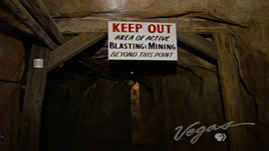Teachers' Domain - Digital Media for the Classroom and Professional Development
User: Preview

Source: Vegas PBS SAT-CHAT Series: “Mine CHAT”
In this video from the Science and Technology Chat series, elementary school students visit the McCaw School of Mines and take a tour of a demonstration mine. First, they learn how gold is extracted from sediment through panning. They also learn about structural safety features and the use of controlled explosions. Finally, they learn that Nevada mines contain large deposits of gypsum, which is used in many everyday items, including drywall.
Minerals are nonliving, naturally occurring chemical compounds. Each mineral contains a different combination of elements, with atoms arranged to form a solid, crystalline substance. The practice of finding and extracting minerals from the ground is called mining. Examples of minerals mined for their economic value are barite, which is used in paper and paint, and gypsum, which is used in compressed powdered form to make the building material drywall.
While these and other mineral resources are actively mined in the U.S., no minerals have a stronger historical tie to Nevada, home of the McCaw School of Mines featured in this video, than precious metals, especially gold. Gold can be found in two kinds of deposits. Placer deposits form where sand, gravel, and other materials have been transported by running water. Lode deposits are mineral-filled cracks, called veins, within quartz rock.
One method of collecting placer gold is called panning. Gold has a high specific gravity, which means it is denser than water and most other minerals. Thus, gold nuggets of varying sizes can be easily separated from a surrounding sediment, or matrix, by adding water. In panning, the dense gold settles at the bottom of a pan, and the matrix gets washed away. While gold can still be extracted in this manner, most gold is mined using one of two other methods—surface or underground mining—whereby minerals are extracted from excavated rock called ore.
Surface mining is used to obtain minerals at or near the surface. Open-pit mines are found in sandy or gravelly terrain, where the surface material covering a deposit is structurally unsuitable for tunneling. Using this method, thousands of tons of ore rock can be moved each day. Because ore rock may contain less than 5/100ths of an ounce of gold per ton of rock, large debris piles form at open-pit mine sites.
Underground, or subsurface, mining is used when mineral resources are located further underground. Underground mining involves the building of tunnels and shafts, and requires scaffolding made of wood or other materials to keep the mine caves structurally safe. Subsurface mining techniques include strip mining, in which layers of rock and soil overlying a lode deposit are blasted with explosives and removed before specialized machines are used to extract the mineral.
Mining can be a highly dangerous and polluting industry. Mineral extraction can also disturb large areas of Earth's surface, leaving gaping holes in mined areas. In recent years, regulations have been put in place in the U.S. to help protect both miners and the environment. Toxic waste products and contaminated water may no longer be dumped onto adjacent land or waters, and reclamation projects are now required to ensure that land can be used again after mining.
 Loading Standards
Loading Standards